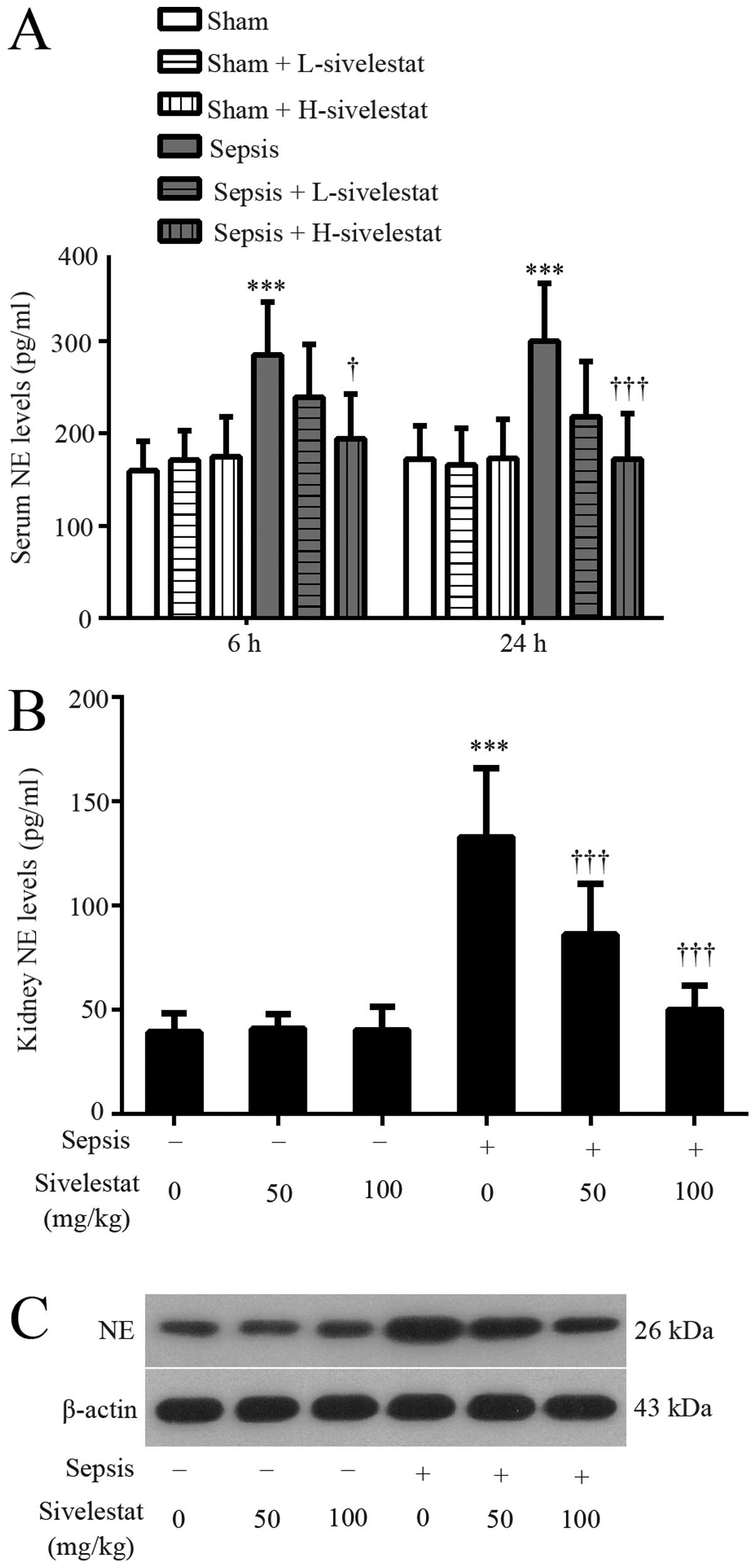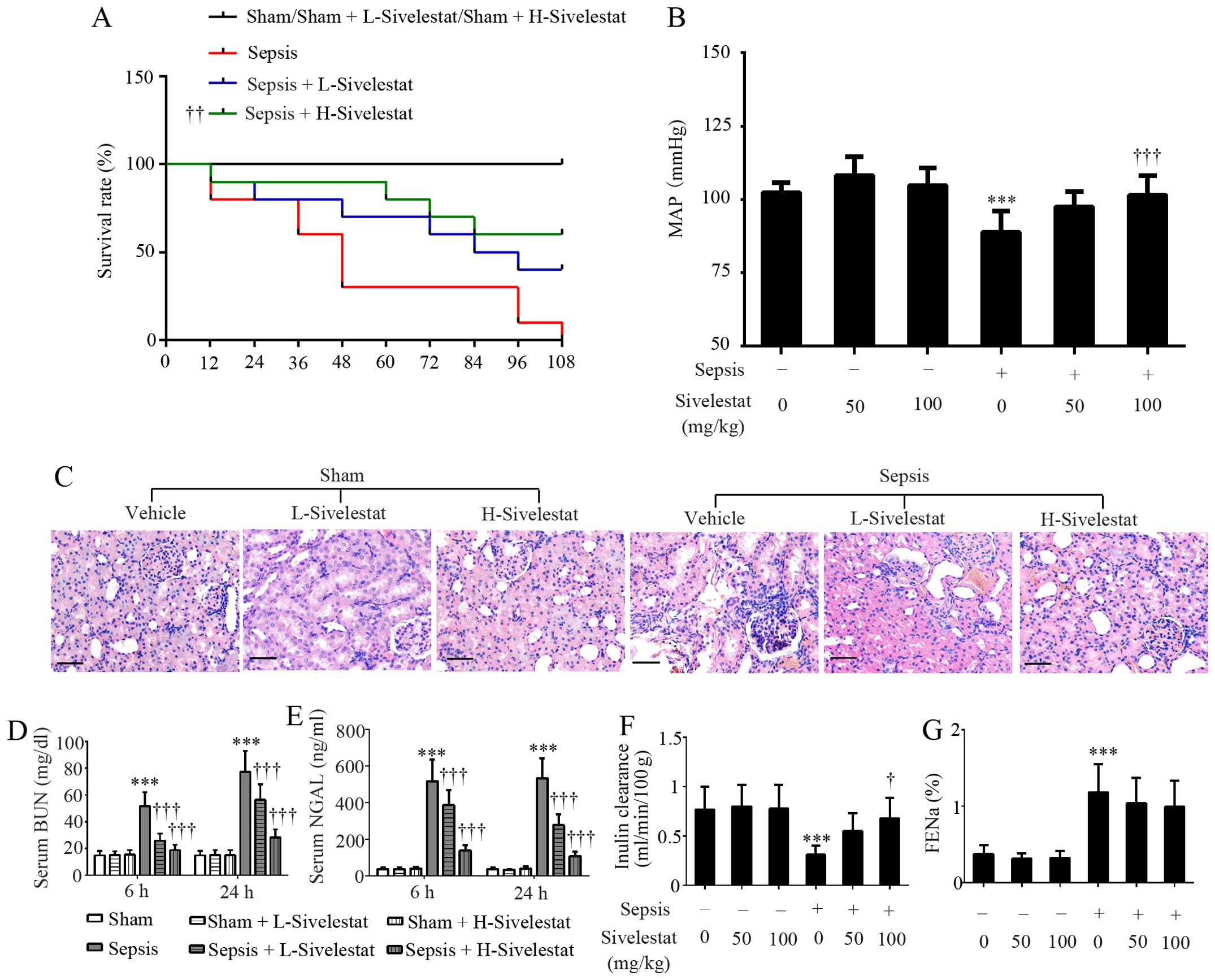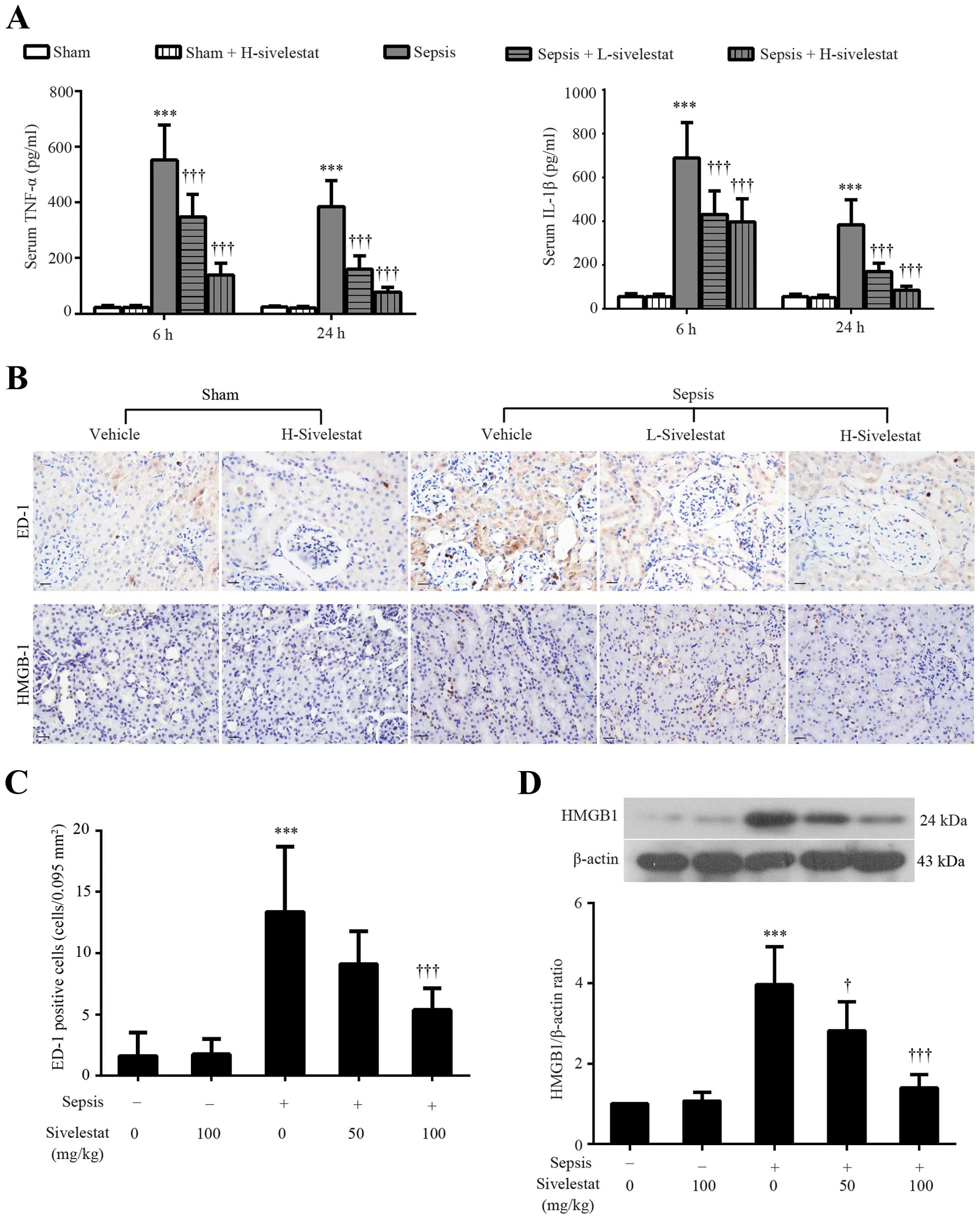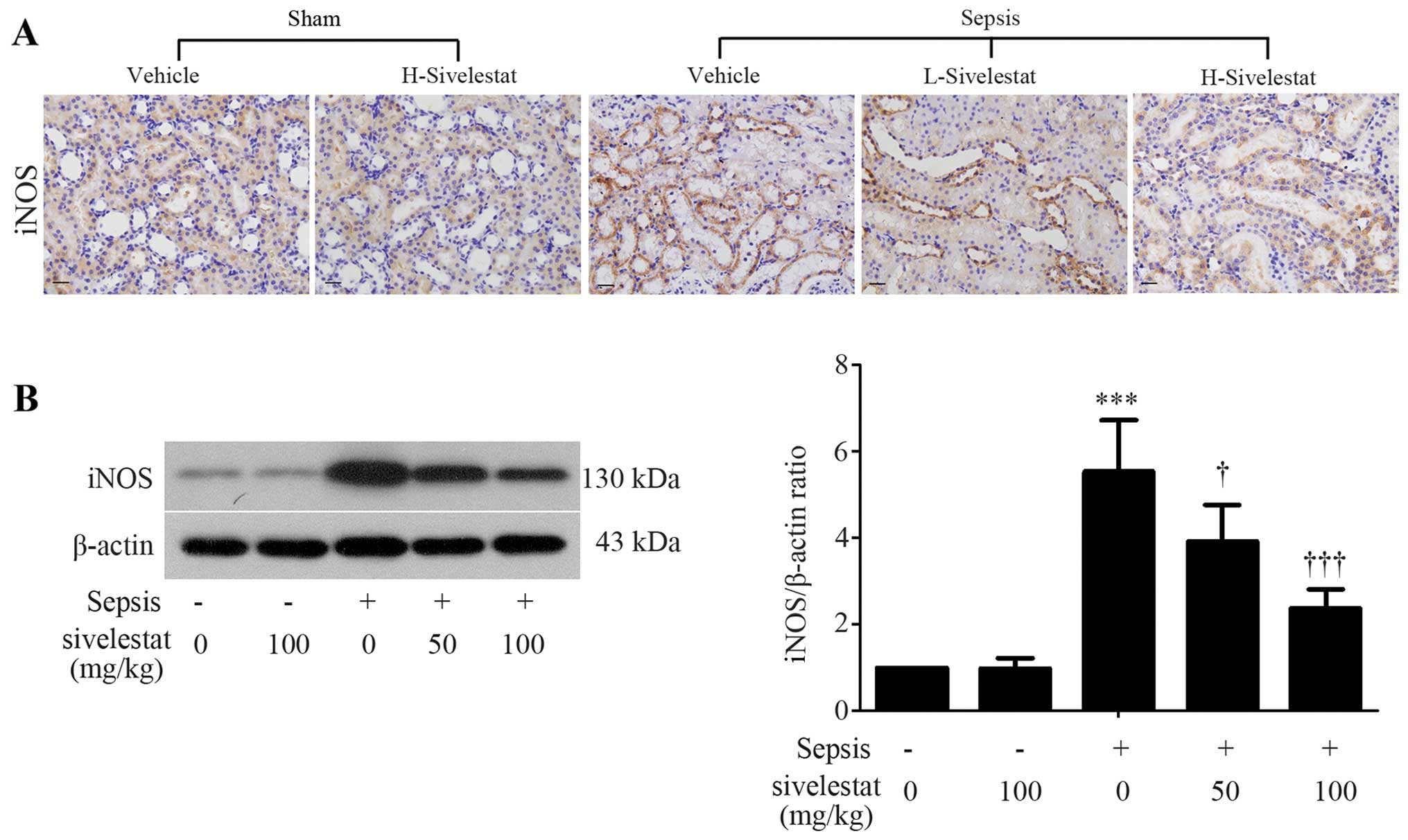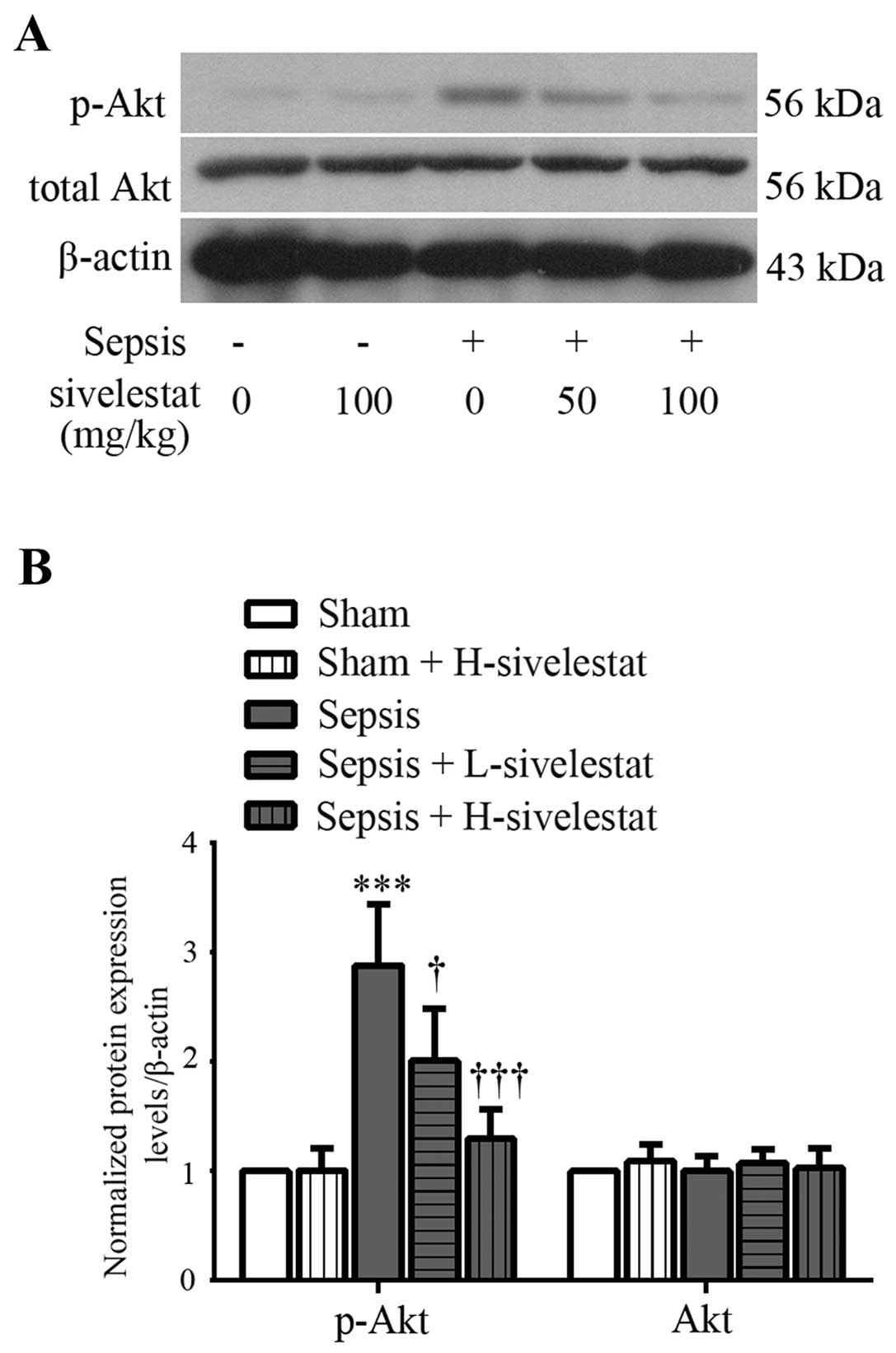|
1
|
Fry DE: Sepsis, systemic inflammatory
response, and multiple organ dysfunction: the mystery continues. Am
Surg. 78:1–8. 2012.PubMed/NCBI
|
|
2
|
Rittirsch D, Flierl MA and Ward PA:
Harmful molecular mechanisms in sepsis. Nat Rev Immunol. 8:776–787.
2008. View
Article : Google Scholar : PubMed/NCBI
|
|
3
|
Morrell ED, Kellum JA, Pastor-Soler NM and
Hallows KR: Septic acute kidney injury: molecular mechanisms and
the importance of stratification and targeting therapy. Crit Care.
18:5012014. View Article : Google Scholar
|
|
4
|
Chen L, Yang S, Zumbrun EE, Guan H,
Nagarkatti PS and Nagarkatti M: Resveratrol attenuates
lipopolysaccharide-induced acute kidney injury by suppressing
inflammation driven by macrophages. Mol Nutr Food Res. 59:853–864.
2015. View Article : Google Scholar : PubMed/NCBI
|
|
5
|
Shimazu R, Akashi S, Ogata H, Nagai Y,
Fukudome K, Miyake K and Kimoto M: MD-2, a molecule that confers
lipopolysaccharide responsiveness on toll-like receptor 4. J Exp
Med. 189:1777–1782. 1999. View Article : Google Scholar : PubMed/NCBI
|
|
6
|
Villar J, Cabrera N, Casula M, Flores C,
Valladares F, Muros M, Blanch L, Slutsky AS and Kacmarek RM:
Mechanical ventilation modulates toll-like receptor signaling
pathway in a sepsis-induced lung injury model. Intensive Care Med.
36:1049–1057. 2010. View Article : Google Scholar : PubMed/NCBI
|
|
7
|
Bang BR, Kim SJ, Yagita H, Croft M and
Kang YJ: Inhibition of 4-1BBL-regulated TLR response in macrophages
ameliorates endotoxin-induced sepsis in mice. Eur J Immunol.
45:886–892. 2015. View Article : Google Scholar :
|
|
8
|
Opal SM, Laterre PF, Francois B, LaRosa
SP, Angus DC, Mira JP, Wittebole X, Dugernier T, Perrotin D,
Tidswell M, et al: ACCESS Study Group: Effect of eritoran, an
antagonist of MD2-TLR4, on mortality in patients with severe
sepsis: the ACCESS randomized trial. JAMA. 309:1154–1162. 2013.
View Article : Google Scholar : PubMed/NCBI
|
|
9
|
Griffin KL, Fischer BM, Kummarapurugu AB,
Zheng S, Kennedy TP, Rao NV, Foster WM and Voynow JA: 2-O,
3-O-desulfated heparin inhibits neutrophil elastase-induced HMGB-1
secretion and airway inflammation. Am J Respir Cell Mol Biol.
50:684–689. 2014. View Article : Google Scholar :
|
|
10
|
Korkmaz B, Horwitz MS, Jenne DE and
Gauthier F: Neutrophil elastase, proteinase 3, and cathepsin G as
therapeutic targets in human diseases. Pharmacol Rev. 62:726–759.
2010. View Article : Google Scholar : PubMed/NCBI
|
|
11
|
Zager RA, Johnson AC and Frostad KB: Rapid
renal alpha-1 antitrypsin gene induction in experimental and
clinical acute kidney injury. PLoS One. 9:e983802014. View Article : Google Scholar : PubMed/NCBI
|
|
12
|
Takemasa A, Ishii Y and Fukuda T: A
neutrophil elastase inhibitor prevents bleomycin-induced pulmonary
fibrosis in mice. Eur Respir J. 40:1475–1482. 2012. View Article : Google Scholar : PubMed/NCBI
|
|
13
|
Ishii T, Doi K, Okamoto K, Imamura M, Dohi
M, Yamamoto K, Fujita T and Noiri E: Neutrophil elastase
contributes to acute lung injury induced by bilateral nephrectomy.
Am J Pathol. 177:1665–1673. 2010. View Article : Google Scholar : PubMed/NCBI
|
|
14
|
Suda K, Takeuchi H, Hagiwara T, Miyasho T,
Okamoto M, Kawasako K, Yamada S, Suganuma K, Wada N, Saikawa Y, et
al: Neutrophil elastase inhibitor improves survival of rats with
clinically relevant sepsis. Shock. 33:526–531. 2010.
|
|
15
|
Schortgen F and Asfar P: Update in sepsis
and acute kidney injury 2014. Am J Respir Crit Care Med.
191:1226–1231. 2015. View Article : Google Scholar : PubMed/NCBI
|
|
16
|
Yan J and Li S and Li S: The role of the
liver in sepsis. Int Rev Immunol. 33:498–510. 2014. View Article : Google Scholar : PubMed/NCBI
|
|
17
|
Drosatos K, Lymperopoulos A, Kennel PJ,
Pollak N, Schulze PC and Goldberg IJ: Pathophysiology of
sepsis-related cardiac dysfunction: driven by inflammation, energy
mismanagement, or both? Curr Heart Fail Rep. 12:130–140. 2015.
View Article : Google Scholar :
|
|
18
|
Rittirsch D, Huber-Lang MS, Flierl MA and
Ward PA: Immunodesign of experimental sepsis by cecal ligation and
puncture. Nat Protoc. 4:31–36. 2009. View Article : Google Scholar : PubMed/NCBI
|
|
19
|
Schick MA, Baar W, Flemming S, Schlegel N,
Wollborn J, Held C, Schneider R, Brock RW, Roewer N and Wunder C:
Sepsis-induced acute kidney injury by standardized colon ascendens
stent peritonitis in rats - a simple, reproducible animal model.
Intensive Care Med Exp. 2:342014. View Article : Google Scholar
|
|
20
|
Souza AC, Volpini RA, Shimizu MH, Sanches
TR, Camara NO, Semedo P, Rodrigues CE, Seguro AC and Andrade L:
Erythropoietin prevents sepsis-related acute kidney injury in rats
by inhibiting NF-κB and upregulating endothelial nitric oxide
synthase. Am J Physiol Renal Physiol. 302:F1045–F1054. 2012.
View Article : Google Scholar : PubMed/NCBI
|
|
21
|
Kadova Z, Dolezelova E, Cermanova J, Hroch
M, Laho T, Muchova L, Staud F, Vitek L, Mokry J, Chladek J, et al:
IL-1 receptor blockade alleviates endotoxin-mediated impairment of
renal drug excretory functions in rats. Am J Physiol Renal Physiol.
308:F388–F399. 2015. View Article : Google Scholar
|
|
22
|
King EG, Bauzá GJ, Mella JR and Remick DG:
Pathophysiologic mechanisms in septic shock. Lab Invest. 94:4–12.
2014. View Article : Google Scholar
|
|
23
|
Diener KR, Al-Dasooqi N, Lousberg EL and
Hayball JD: The multifunctional alarmin HMGB1 with roles in the
pathophysiology of sepsis and cancer. Immunol Cell Biol.
91:443–450. 2013. View Article : Google Scholar : PubMed/NCBI
|
|
24
|
Heemskerk S, Masereeuw R, Russel FG and
Pickkers P: Selective iNOS inhibition for the treatment of
sepsis-induced acute kidney injury. Nat Rev Nephrol. 5:629–640.
2009. View Article : Google Scholar : PubMed/NCBI
|
|
25
|
Lowenstein CJ and Padalko E: iNOS (NOS2)
at a glance. J Cell Sci. 117:2865–2867. 2004. View Article : Google Scholar : PubMed/NCBI
|
|
26
|
Fink MP and Warren HS: Strategies to
improve drug development for sepsis. Nat Rev Drug Discov.
13:741–758. 2014. View
Article : Google Scholar : PubMed/NCBI
|
|
27
|
Buras JA, Holzmann B and Sitkovsky M:
Animal models of sepsis: setting the stage. Nat Rev Drug Discov.
4:854–865. 2005. View
Article : Google Scholar : PubMed/NCBI
|
|
28
|
Brooks HF, Osabutey CK, Moss RF, Andrews
PL and Davies DC: Caecal ligation and puncture in the rat mimics
the pathophysiological changes in human sepsis and causes
multi-organ dysfunction. Metab Brain Dis. 22:353–373. 2007.
View Article : Google Scholar : PubMed/NCBI
|
|
29
|
Hirche TO, Benabid R, Deslee G, Gangloff
S, Achilefu S, Guenounou M, Lebargy F, Hancock RE and Belaaouaj A:
Neutrophil elastase mediates innate host protection against
Pseudomonas aeruginosa. J Immunol. 181:4945–4954. 2008. View Article : Google Scholar : PubMed/NCBI
|
|
30
|
Kawabata K, Suzuki M, Sugitani M, Imaki K,
Toda M and Miyamoto T: ONO-5046, a novel inhibitor of human
neutrophil elastase. Biochem Biophys Res Commun. 177:814–820. 1991.
View Article : Google Scholar : PubMed/NCBI
|
|
31
|
Yoshikawa N, Inomata T, Okada Y, Shimbo T,
Takahashi M, Akita K, Uesugi Y and Narumi Y: Sivelestat sodium
hydrate reduces radiation-induced lung injury in mice by inhibiting
neutrophil elastase. Mol Med Rep. 7:1091–1095. 2013.PubMed/NCBI
|
|
32
|
Kohira S, Oka N, Inoue N, Itatani K,
Kitamura T, Horai T, Oshima H, Tojo K, Yoshitake S and Miyaji K:
Effect of additional preoperative administration of the neutrophil
elastase inhibitor sivelestat on perioperative inflammatory
response after pediatric heart surgery with cardiopulmonary bypass.
Artif Organs. 38:1018–1023. 2014. View Article : Google Scholar : PubMed/NCBI
|
|
33
|
Nomura N, Asano M, Saito T, Nakayama T and
Mishima A: Sivelestat attenuates lung injury in surgery for
congenital heart disease with pulmonary hypertension. Ann Thorac
Surg. 96:2184–2191. 2013. View Article : Google Scholar : PubMed/NCBI
|
|
34
|
Tagami T, Tosa R, Omura M, Fukushima H,
Kaneko T, Endo T, Rinka H, Murai A, Yamaguchi J, Yoshikawa K, et
al: Effect of a selective neutrophil elastase inhibitor on
mortality and ventilator-free days in patients with increased
extravascular lung water: a post hoc analysis of the PiCCO
Pulmonary Edema Study. J Intensive Care. 2:672014. View Article : Google Scholar
|
|
35
|
Sakai S, Tajima H, Miyashita T, Nakanuma
S, Makino I, Hayashi H, Nakagawara H, Kitagawa H, Fushida S,
Fujimura T, et al: Sivelestat sodium hydrate inhibits neutrophil
migration to the vessel wall and suppresses hepatic
ischemia-reperfusion injury. Dig Dis Sci. 59:787–794. 2014.
View Article : Google Scholar
|
|
36
|
Cao J and Liu Q: Protective effects of
sivelestat in a caerulein-induced rat acute pancreatitis model.
Inflammation. 36:1348–1356. 2013. View Article : Google Scholar : PubMed/NCBI
|
|
37
|
Jang HR and Rabb H: Immune cells in
experimental acute kidney injury. Nat Rev Nephrol. 11:88–101. 2015.
View Article : Google Scholar
|
|
38
|
Yang H, Ochani M, Li J, Qiang X, Tanovic
M, Harris HE, Susarla SM, Ulloa L, Wang H, DiRaimo R, et al:
Reversing established sepsis with antagonists of endogenous
high-mobility group box 1. Proc Natl Acad Sci USA. 101:296–301.
2004. View Article : Google Scholar :
|
|
39
|
Lingaraju MC, Pathak NN, Begum J,
Balaganur V, Ramachandra HD, Bhat RA, Ram M, Singh V, Kandasamy K,
Kumar D, et al: Betulinic acid attenuates renal oxidative stress
and inflammation in experimental model of murine polymicrobial
sepsis. Eur J Pharm Sci. 70:12–21. 2015. View Article : Google Scholar : PubMed/NCBI
|
|
40
|
Carrino DA, Lidor C, Edelstein S and
Caplan AI: Proteoglycan synthesis in vitamin D-deficient cartilage:
recovery from vitamin D deficiency. Connect Tissue Res. 19:135–147.
1989. View Article : Google Scholar : PubMed/NCBI
|
|
41
|
Zhang H, Wang W, Fang H, Yang Y, Li X, He
J, Jiang X, Wang W, Liu S, Hu J, et al: GSK-3β inhibition
attenuates CLP-induced liver injury by reducing inflammation and
hepatic cell apoptosis. Mediators Inflamm. 2014:6295072014.
View Article : Google Scholar
|
|
42
|
Scaffidi P, Misteli T and Bianchi ME:
Release of chromatin protein HMGB1 by necrotic cells triggers
inflammation. Nature. 418:191–195. 2002. View Article : Google Scholar : PubMed/NCBI
|
|
43
|
Wang H, Liao H, Ochani M, Justiniani M,
Lin X, Yang L, Al-Abed Y, Wang H, Metz C, Miller EJ, et al:
Cholinergic agonists inhibit HMGB1 release and improve survival in
experimental sepsis. Nat Med. 10:1216–1221. 2004. View Article : Google Scholar : PubMed/NCBI
|
|
44
|
Hagiwara S, Iwasaka H, Togo K and Noguchi
T: A neutrophil elastase inhibitor, sivelestat, reduces lung injury
following endotoxin-induced shock in rats by inhibiting HMGB1.
Inflammation. 31:227–234. 2008. View Article : Google Scholar : PubMed/NCBI
|
|
45
|
Abraham E, Laterre PF, Garbino J,
Pingleton S, Butler T, Dugernier T, Margolis B, Kudsk K, Zimmerli
W, Anderson P, et al: Lenercept (p55 tumor necrosis factor receptor
fusion protein) in severe sepsis and early septic shock: a
randomized, double-blind, placebo-controlled, multicenter phase III
trial with 1,342 patients. Crit Care Med. 29:503–510. 2001.
View Article : Google Scholar : PubMed/NCBI
|
|
46
|
Fisher CJ Jr, Dhainaut JF, Opal SM,
Pribble JP, Balk RA, Slotman GJ, Iberti TJ, Rackow EC, Shapiro MJ,
Greenman RL, et al: Recombinant human interleukin 1 receptor
antagonist in the treatment of patients with sepsis syndrome.
Results from a randomized, double-blind, placebo-controlled trial.
Phase III rhIL-1ra Sepsis Syndrome Study Group. JAMA.
271:1836–1843. 1994. View Article : Google Scholar : PubMed/NCBI
|
|
47
|
Cauwels A: Nitric oxide in shock. Kidney
Int. 72:557–565. 2007. View Article : Google Scholar : PubMed/NCBI
|
|
48
|
Hagiwara S, Iwasaka H, Hidaka S, Hasegawa
A and Noguchi T: Neutrophil elastase inhibitor (sivelestat) reduces
the levels of inflammatory mediators by inhibiting NF-kB. Inflamm
Res. 58:198–203. 2009. View Article : Google Scholar : PubMed/NCBI
|
|
49
|
Toda Y, Takahashi T, Maeshima K, Shimizu
H, Inoue K, Morimatsu H, Omori E, Takeuchi M, Akagi R and Morita K:
A neutrophil elastase inhibitor, sivelestat, ameliorates lung
injury after hemorrhagic shock in rats. Int J Mol Med. 19:237–243.
2007.PubMed/NCBI
|
|
50
|
He Z, Zhu Y and Jiang H: Inhibiting
toll-like receptor 4 signaling ameliorates pulmonary fibrosis
during acute lung injury induced by lipopolysaccharide: an
experimental study. Respir Res. 10:1262009. View Article : Google Scholar : PubMed/NCBI
|
|
51
|
Kim TH, Kim SJ and Lee SM: Stimulation of
the α7 nicotinic acetylcholine receptor protects against sepsis by
inhibiting toll-like receptor via phosphoinositide 3-kinase
activation. J Infect Dis. 209:1668–1677. 2014. View Article : Google Scholar
|
|
52
|
Li C, Hua F, Ha T, Singh K, Lu C,
Kalbfleisch J, Breuel KF, Ford T, Kao RL, Gao M, et al: Activation
of myocardial phos-phoinositide-3-kinase p110α ameliorates cardiac
dysfunction and improves survival in polymicrobial sepsis. PLoS
One. 7:e447122012. View Article : Google Scholar
|
|
53
|
Sadhu C, Dick K, Tino WT and Staunton DE:
Selective role of PI3K delta in neutrophil inflammatory responses.
Biochem Biophys Res Commun. 308:764–769. 2003. View Article : Google Scholar : PubMed/NCBI
|
|
54
|
Araki Y, Matsumiya M, Matsuura T, Kaibori
M, Okumura T, Nishizawa M and Kwon AH: Sivelestat suppresses iNOS
gene expression in proinflammatory cytokine-stimulated hepatocytes.
Dig Dis Sci. 56:1672–1681. 2011. View Article : Google Scholar : PubMed/NCBI
|
|
55
|
Wu F, Zhang W, Li L, Zheng F, Shao X, Zhou
J and Li H: Inhibitory effects of honokiol on
lipopolysaccharide-induced cellular responses and signaling events
in human renal mesangial cells. Eur J Pharmacol. 654:117–121. 2011.
View Article : Google Scholar
|



